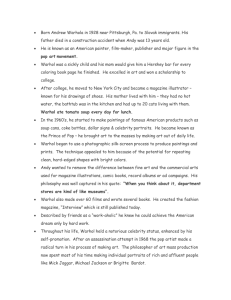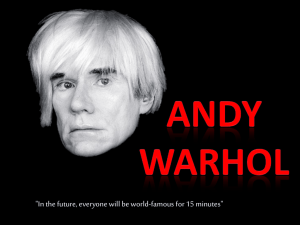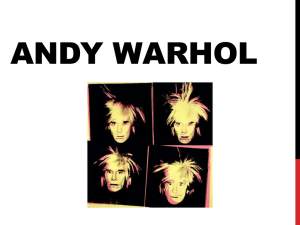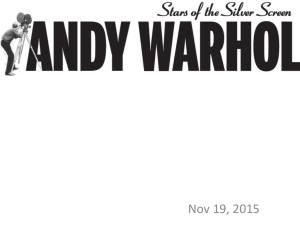Andy Warhol - LaPazColegio2014-2015
advertisement
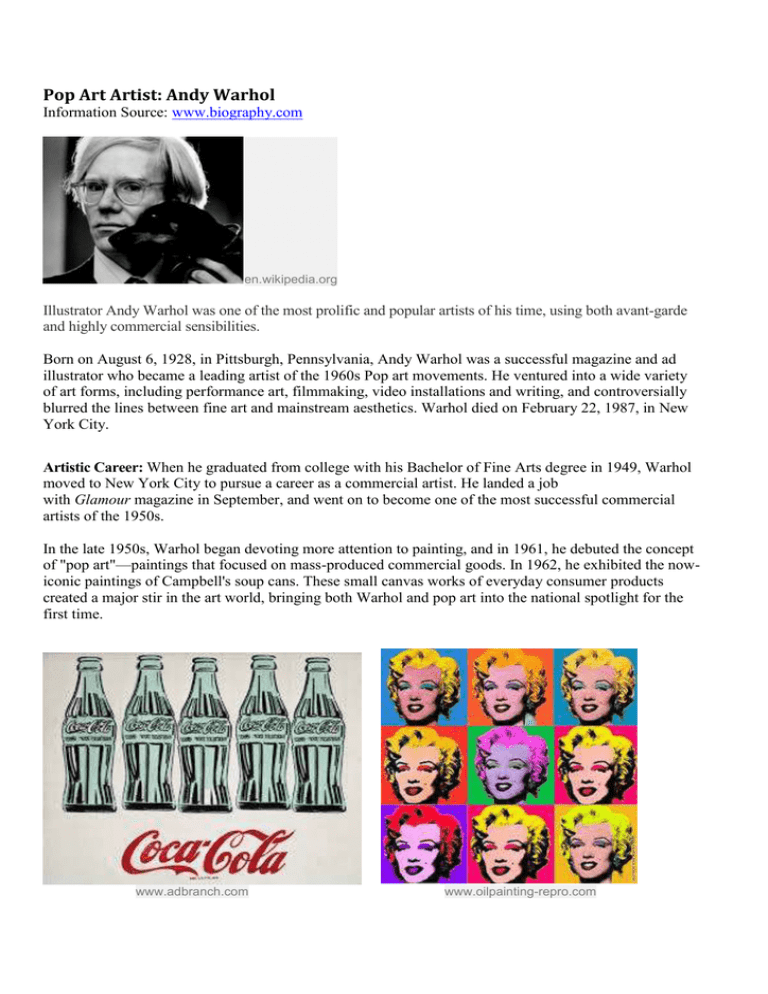
Pop Art Artist: Andy Warhol Information Source: www.biography.com en.wikipedia.org Illustrator Andy Warhol was one of the most prolific and popular artists of his time, using both avant-garde and highly commercial sensibilities. Born on August 6, 1928, in Pittsburgh, Pennsylvania, Andy Warhol was a successful magazine and ad illustrator who became a leading artist of the 1960s Pop art movements. He ventured into a wide variety of art forms, including performance art, filmmaking, video installations and writing, and controversially blurred the lines between fine art and mainstream aesthetics. Warhol died on February 22, 1987, in New York City. Artistic Career: When he graduated from college with his Bachelor of Fine Arts degree in 1949, Warhol moved to New York City to pursue a career as a commercial artist. He landed a job with Glamour magazine in September, and went on to become one of the most successful commercial artists of the 1950s. In the late 1950s, Warhol began devoting more attention to painting, and in 1961, he debuted the concept of "pop art"—paintings that focused on mass-produced commercial goods. In 1962, he exhibited the nowiconic paintings of Campbell's soup cans. These small canvas works of everyday consumer products created a major stir in the art world, bringing both Warhol and pop art into the national spotlight for the first time. www.adbranch.com www.oilpainting-repro.com Warhol's other famous pop paintings depicted Coca-cola bottles, vacuum cleaners and hamburgers. He also painted celebrity portraits in vivid and garish colors; his most famous subjects include Marilyn Monroe, Elizabeth Taylor, Mick Jagger and Mao Zedong. As these portraits gained fame and notoriety, Warhol began to receive hundreds of commissions for portraits from socialites and celebrities. His portrait " Eight Elvises" eventually resold for $100 million in 2008, making it one of the most valuable paintings in world history. In 1964, Warhol opened his own art studio, a large silver-painted warehouse known simply as "The Factory." The Factory quickly became one of New York City's premier cultural hotspots, a scene of lavish parties attended by the city's wealthiest socialites and celebrities. Warhol, who clearly relished his celebrity, became a fixture at infamous New York City nightclubs like Studio 54 and Max's Kansas City. Commenting on celebrity fixation—his own and that of the public at large—Warhol observed, "more than anything people just want stars." www.msu.edu totallyhistory.com In the 1970s, Warhol began expanding into new artistic mediums. He put together his first book, Andy Warhol's Index, in 1967, and released several other titles such as The Philosophy of Andy Warhol (From A to B and Back Again) and Exposures in the 1970s. Warhol also experimented extensively with video art, producing more than 60 films during his career. Warhol also worked in sculpture and photography, and in the 1980s, he moved into television, hosting Andy Warhol's TV and Andy Warhol's Fifteen Minutes on MTV Death and Legacy: Warhol died on February 22, 1987, at the age of 58. Warhol's life and work simultaneously satirized and celebrated materiality and celebrity. On the one hand, his paintings of distorted brand images and celebrity faces could be read as a critique of what he viewed as a culture obsessed with money and celebrity. On the other hand, Warhol's focus on consumer goods and popculture icons, as well as his own taste for money and fame, suggest a life in celebration of the very aspects of American culture that his work criticized. Warhol spoke to this apparent contradiction between his life and work in his book The Philosophy of Andy Warhol, writing that "making money is art and working is art, and good business is the best art.
